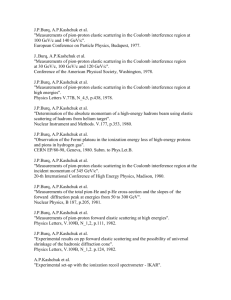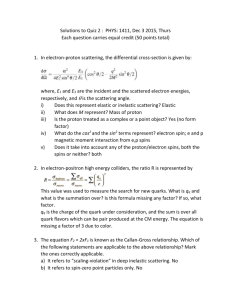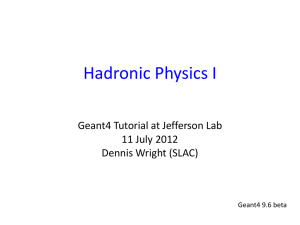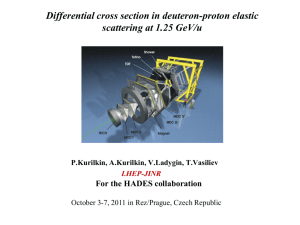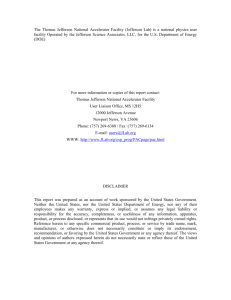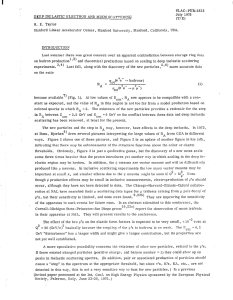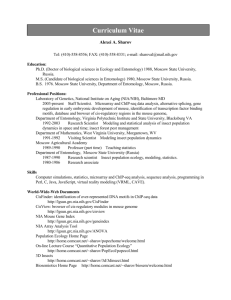27-Ratio_Rdp_Prokofiev
advertisement
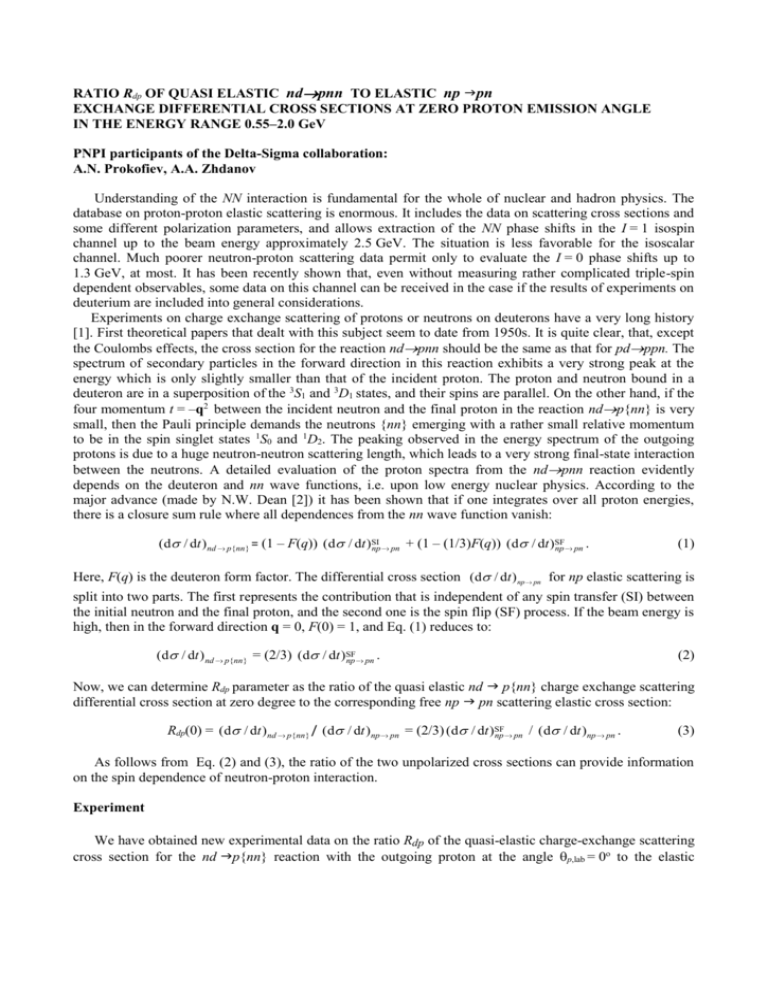
RATIO Rdp OF QUASI ELASTIC ndpnn TO ELASTIC np pn
EXCHANGE DIFFERENTIAL CROSS SECTIONS AT ZERO PROTON EMISSION ANGLE
IN THE ENERGY RANGE 0.55–2.0 GeV
PNPI participants of the Delta-Sigma collaboration:
A.N. Prokofiev, A.A. Zhdanov
Understanding of the NN interaction is fundamental for the whole of nuclear and hadron physics. The
database on proton-proton elastic scattering is enormous. It includes the data on scattering cross sections and
some different polarization parameters, and allows extraction of the NN phase shifts in the I = 1 isospin
channel up to the beam energy approximately 2.5 GeV. The situation is less favorable for the isoscalar
channel. Much poorer neutron-proton scattering data permit only to evaluate the I = 0 phase shifts up to
1.3 GeV, at most. It has been recently shown that, even without measuring rather complicated triple-spin
dependent observables, some data on this channel can be received in the case if the results of experiments on
deuterium are included into general considerations.
Experiments on charge exchange scattering of protons or neutrons on deuterons have a very long history
[1]. First theoretical papers that dealt with this subject seem to date from 1950s. It is quite clear, that, except
the Coulombs effects, the cross section for the reaction ndpnn should be the same as that for pdppn. The
spectrum of secondary particles in the forward direction in this reaction exhibits a very strong peak at the
energy which is only slightly smaller than that of the incident proton. The proton and neutron bound in a
deuteron are in a superposition of the 3S1 and 3D1 states, and their spins are parallel. On the other hand, if the
four momentum t = –q2 between the incident neutron and the final proton in the reaction ndp{nn} is very
small, then the Pauli principle demands the neutrons {nn} emerging with a rather small relative momentum
to be in the spin singlet states 1S0 and 1D2. The peaking observed in the energy spectrum of the outgoing
protons is due to a huge neutron-neutron scattering length, which leads to a very strong final-state interaction
between the neutrons. A detailed evaluation of the proton spectra from the ndpnn reaction evidently
depends on the deuteron and nn wave functions, i.e. upon low energy nuclear physics. According to the
major advance (made by N.W. Dean [2]) it has been shown that if one integrates over all proton energies,
there is a closure sum rule where all dependences from the nn wave function vanish:
SF
(d / dt ) nd –› p{nn} = (1 – F(q)) (d / dt )SI
np –› pn + (1 – (1/3)F(q)) (d / dt ) np –› pn .
(1)
Here, F(q) is the deuteron form factor. The differential cross section (d / dt ) np –› pn for np elastic scattering is
split into two parts. The first represents the contribution that is independent of any spin transfer (SI) between
the initial neutron and the final proton, and the second one is the spin flip (SF) process. If the beam energy is
high, then in the forward direction q = 0, F(0) = 1, and Eq. (1) reduces to:
(d / dt ) nd –› p{nn} = (2/3) (d / dt )SF
np –› pn .
(2)
Now, we can determine Rdp parameter as the ratio of the quasi elastic nd p{nn} charge exchange scattering
differential cross section at zero degree to the corresponding free np pn scattering elastic cross section:
Rdp(0) = (d / dt ) nd –› p{nn} / (d / dt )np –› pn = (2/3) (d / dt )SF
np –› pn / (d / dt ) np –› pn .
(3)
As follows from Eq. (2) and (3), the ratio of the two unpolarized cross sections can provide information
on the spin dependence of neutron-proton interaction.
Experiment
We have obtained new experimental data on the ratio Rdp of the quasi-elastic charge-exchange scattering
cross section for the nd p{nn} reaction with the outgoing proton at the angle p,lab = 0o to the elastic
np pn charge exchange scattering cross section. The measurements were carried out at the NUCLOTRON
accelerator (JINR, Dubna) at neutron beam kinetic energies 0.55, 0.8, 1.0, 1.2, 1.4, 1.8, and 2.0 GeV. An
intense neutron beam with a small momentum spread was produced by breakup of the accelerated deuterons.
In study of both the reactions, the outgoing protons were detected with the momentum pp approximately
equal to the incident neutron momentum in the direction close to that of the incident neutron beam, i.e. in the
vicinity of the scattering angle p,lab = 0o. The data were obtained with a set-up (Fig. 1) consisting of an
analysing magnet SP-94 and two sets of multiwire proportional chambers, located downstream and upstream
of the magnet. The time-of-flight measurement system was applied to identify the detected particles. The
influence of the inelastic background processes was considerably reduced by an additional detector system
surrounding the liquid hydrogen (or deuterium) target. Some calibration measurements were performed with
polyethylene CD or CH targets.
Fig. 1: Magnetic spectrometer for detection of protons scattered at zero degree laboratory angle in the ndpnn and nppn
charge-exchange reactions. SP-94 is the analysing dipole magnet; Gx,y, 1x, 2x, 3x,y, 4y,x are multiwire proportional chambers;
H2/D2 is the liquid hydrogen/deuterium target; S1, TOF1,2, A, and ST1,2,3 are the time-of-flight and trigger counters
Fig. 2: Energy dependence of Rdp. Black
squares – this experiment [3–5], open squares
and circles – the existing data at energies
below 1 Gev [1]. The open squares represent
the data obtained in nd p{nn} reaction
measurements and the open circles represent
the data obtained in either pd npp or
dp ppn reaction measurements. The point at
Tn = 0.98 GeV is from the hydrogen bubble
chamber experiment carried out at JINR [6]
The obtained results for Rdp = [(ddnd)] / [(d/d) (np)] are shown in Fig. 2. The ratios of the quasielastic nd p{nn} charge-exchange yield to the free elastic np pn yield were measured at 0.55, 0.8, 1.0,
1.2, 1.4, 1.8, and 2.0 GeV. The present data are obtained for the first time for the energy above 1 Gev [3–5].
We have found that the Rdp values are relatively large (close to 0.56) and almost independent of energy, at
least up to 2 GeV. The used experimental method has provided very precise results. The systematic
uncertainties are small since both the cross sections were measured with the same set-up. A reasonably quick
replacement of the “full’ and “empty” targets allowed to suppress possible systematic errors caused by
influence of time and temperature drifts of the detector efficiency. The obtained data were compared with the
results of different phase shift analyses in the region of confident np scattering data (below 1.3 GeV) [7]. It
was found that our data are in good agreement in this region with the results of earlier experiments. In
general, the data seem to be rather far from the allowed theoretical limit of 0.67. On the other hand, the phase
shift analysis (PSA) [7] predicts that the contribution from the spin-independent term should be very small in
the region of our investigation. The data of the present work might help to understand this disagreement.
References
1. F. Lehar, C. Wilkin, arxiv:0911.1699v1[nucl-ex], (2009).
2. N.W. Dean, Phys. Rev. D 5, 1661 (1972); Phys. Rev. D 5, 2832 (1972).
3. V. I. Sharov et al., Czech. J. Phys. 56, F117 (2006).
4. V. I. Sharov et al., Eur. Phys. J. A 39, 267 (2009).
5. V. I. Sharov et al., Phys. Atom. Nucl. 72, 1007 (2009).
6. V.V. Glagolev et al., JINR Communication P1-2006-112, JINR, Dubna (2006).
7. R. Arndt et al., Phys. Rev, C 76, 025209 (2007), http://gwdec.phys.gwu.edu.
